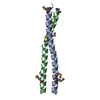+ Open data
Open data
- Basic information
Basic information
| Entry | Database: PDB / ID: 7k36 | ||||||||||||||||||
|---|---|---|---|---|---|---|---|---|---|---|---|---|---|---|---|---|---|---|---|
| Title | Cryo-EM structure of STRIPAK complex | ||||||||||||||||||
 Components Components |
| ||||||||||||||||||
 Keywords Keywords | SIGNALING PROTEIN / phosphorylation / complex / PP2A | ||||||||||||||||||
| Function / homology |  Function and homology information Function and homology informationarmadillo repeat domain binding / meiotic spindle elongation / Integration of energy metabolism / PP2A-mediated dephosphorylation of key metabolic factors / RNA polymerase II CTD heptapeptide repeat S2 phosphatase activity / RNA polymerase II CTD heptapeptide repeat S7 phosphatase activity / MASTL Facilitates Mitotic Progression / protein phosphatase type 2A complex / protein serine/threonine phosphatase complex / peptidyl-threonine dephosphorylation ...armadillo repeat domain binding / meiotic spindle elongation / Integration of energy metabolism / PP2A-mediated dephosphorylation of key metabolic factors / RNA polymerase II CTD heptapeptide repeat S2 phosphatase activity / RNA polymerase II CTD heptapeptide repeat S7 phosphatase activity / MASTL Facilitates Mitotic Progression / protein phosphatase type 2A complex / protein serine/threonine phosphatase complex / peptidyl-threonine dephosphorylation / regulation of meiotic cell cycle process involved in oocyte maturation / mitotic sister chromatid separation / meiotic sister chromatid cohesion, centromeric / INTAC complex / RNA polymerase II CTD heptapeptide repeat S5 phosphatase activity / FAR/SIN/STRIPAK complex / Regulation of glycolysis by fructose 2,6-bisphosphate metabolism / negative regulation of intracellular estrogen receptor signaling pathway / Inhibition of replication initiation of damaged DNA by RB1/E2F1 / female meiotic nuclear division / protein phosphatase regulator activity / GABA receptor binding / APC truncation mutants have impaired AXIN binding / AXIN missense mutants destabilize the destruction complex / Truncations of AMER1 destabilize the destruction complex / protein antigen binding / ERKs are inactivated / positive regulation of extrinsic apoptotic signaling pathway in absence of ligand / Initiation of Nuclear Envelope (NE) Reformation / Beta-catenin phosphorylation cascade / Signaling by GSK3beta mutants / CTNNB1 S33 mutants aren't phosphorylated / CTNNB1 S37 mutants aren't phosphorylated / CTNNB1 S45 mutants aren't phosphorylated / CTNNB1 T41 mutants aren't phosphorylated / RNA polymerase II transcription initiation surveillance / Co-stimulation by CD28 / regulation of cell morphogenesis / regulation of growth / Disassembly of the destruction complex and recruitment of AXIN to the membrane / cortical actin cytoskeleton organization / negative regulation of epithelial to mesenchymal transition / Golgi cisterna membrane / Co-inhibition by CTLA4 / Platelet sensitization by LDL / protein-serine/threonine phosphatase / negative regulation of glycolytic process through fructose-6-phosphate / positive regulation of NLRP3 inflammasome complex assembly / ERK/MAPK targets / protein serine/threonine phosphatase activity / mesoderm development / vascular endothelial cell response to oscillatory fluid shear stress / T cell homeostasis / regulation of cell differentiation / regulation of microtubule polymerization / phosphoprotein phosphatase activity / regulation of G1/S transition of mitotic cell cycle / lateral plasma membrane / chromosome, centromeric region / DARPP-32 events / negative regulation of hippo signaling / protein dephosphorylation / Nonsense Mediated Decay (NMD) enhanced by the Exon Junction Complex (EJC) / Cyclin A/B1/B2 associated events during G2/M transition / spindle assembly / Amplification of signal from unattached kinetochores via a MAD2 inhibitory signal / cytoskeleton organization / Loss of Nlp from mitotic centrosomes / Loss of proteins required for interphase microtubule organization from the centrosome / Mitotic Prometaphase / Recruitment of mitotic centrosome proteins and complexes / EML4 and NUDC in mitotic spindle formation / negative regulation of phosphatidylinositol 3-kinase/protein kinase B signal transduction / Recruitment of NuMA to mitotic centrosomes / protein tyrosine phosphatase activity / Anchoring of the basal body to the plasma membrane / protein phosphatase 2A binding / Resolution of Sister Chromatid Cohesion / Turbulent (oscillatory, disturbed) flow shear stress activates signaling by PIEZO1 and integrins in endothelial cells / AURKA Activation by TPX2 / meiotic cell cycle / chromosome segregation / RAF activation / Spry regulation of FGF signaling / RHO GTPases Activate Formins / negative regulation of canonical Wnt signaling pathway / PKR-mediated signaling / Degradation of beta-catenin by the destruction complex / response to lead ion / small GTPase binding / tau protein binding / spindle pole / Negative regulation of MAPK pathway / Cyclin D associated events in G1 / Separation of Sister Chromatids / Regulation of TP53 Degradation / Regulation of PLK1 Activity at G2/M Transition / response to estradiol / mitotic cell cycle / microtubule cytoskeleton Similarity search - Function | ||||||||||||||||||
| Biological species |  Homo sapiens (human) Homo sapiens (human) | ||||||||||||||||||
| Method | ELECTRON MICROSCOPY / single particle reconstruction / cryo EM / Resolution: 3.3 Å | ||||||||||||||||||
 Authors Authors | Jeong, B.-C. / Bai, X.C. | ||||||||||||||||||
| Funding support |  United States, 5items United States, 5items
| ||||||||||||||||||
 Citation Citation |  Journal: Nat Struct Mol Biol / Year: 2021 Journal: Nat Struct Mol Biol / Year: 2021Title: Cryo-EM structure of the Hippo signaling integrator human STRIPAK. Authors: Byung-Cheon Jeong / Sung Jun Bae / Lisheng Ni / Xuewu Zhang / Xiao-Chen Bai / Xuelian Luo /  Abstract: The striatin-interacting phosphatase and kinase (STRIPAK) complex is a large, multisubunit protein phosphatase 2A (PP2A) assembly that integrates diverse cellular signals in the Hippo pathway to ...The striatin-interacting phosphatase and kinase (STRIPAK) complex is a large, multisubunit protein phosphatase 2A (PP2A) assembly that integrates diverse cellular signals in the Hippo pathway to regulate cell proliferation and survival. The architecture and assembly mechanism of this critical complex are poorly understood. Using cryo-EM, we determine the structure of the human STRIPAK core comprising PP2AA, PP2AC, STRN3, STRIP1, and MOB4 at 3.2-Å resolution. Unlike the canonical trimeric PP2A holoenzyme, STRIPAK contains four copies of STRN3 and one copy of each the PP2AA-C heterodimer, STRIP1, and MOB4. The STRN3 coiled-coil domains form an elongated homotetrameric scaffold that links the complex together. An inositol hexakisphosphate (IP) is identified as a structural cofactor of STRIP1. Mutations of key residues at subunit interfaces disrupt the integrity of STRIPAK, causing aberrant Hippo pathway activation. Thus, STRIPAK is established as a noncanonical PP2A complex with four copies of regulatory STRN3 for enhanced signal integration. | ||||||||||||||||||
| History |
|
- Structure visualization
Structure visualization
| Movie |
 Movie viewer Movie viewer |
|---|---|
| Structure viewer | Molecule:  Molmil Molmil Jmol/JSmol Jmol/JSmol |
- Downloads & links
Downloads & links
- Download
Download
| PDBx/mmCIF format |  7k36.cif.gz 7k36.cif.gz | 431.2 KB | Display |  PDBx/mmCIF format PDBx/mmCIF format |
|---|---|---|---|---|
| PDB format |  pdb7k36.ent.gz pdb7k36.ent.gz | 316.2 KB | Display |  PDB format PDB format |
| PDBx/mmJSON format |  7k36.json.gz 7k36.json.gz | Tree view |  PDBx/mmJSON format PDBx/mmJSON format | |
| Others |  Other downloads Other downloads |
-Validation report
| Summary document |  7k36_validation.pdf.gz 7k36_validation.pdf.gz | 1 MB | Display |  wwPDB validaton report wwPDB validaton report |
|---|---|---|---|---|
| Full document |  7k36_full_validation.pdf.gz 7k36_full_validation.pdf.gz | 1.1 MB | Display | |
| Data in XML |  7k36_validation.xml.gz 7k36_validation.xml.gz | 62.6 KB | Display | |
| Data in CIF |  7k36_validation.cif.gz 7k36_validation.cif.gz | 95.5 KB | Display | |
| Arichive directory |  https://data.pdbj.org/pub/pdb/validation_reports/k3/7k36 https://data.pdbj.org/pub/pdb/validation_reports/k3/7k36 ftp://data.pdbj.org/pub/pdb/validation_reports/k3/7k36 ftp://data.pdbj.org/pub/pdb/validation_reports/k3/7k36 | HTTPS FTP |
-Related structure data
| Related structure data |  22650MC M: map data used to model this data C: citing same article ( |
|---|---|
| Similar structure data |
- Links
Links
- Assembly
Assembly
| Deposited unit | 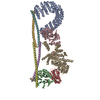
|
|---|---|
| 1 |
|
- Components
Components
-Serine/threonine-protein phosphatase 2A ... , 2 types, 2 molecules AC
| #1: Protein | Mass: 65378.344 Da / Num. of mol.: 1 Source method: isolated from a genetically manipulated source Source: (gene. exp.)  Homo sapiens (human) / Gene: PPP2R1A / Details (production host): pBIG / Cell line (production host): High Five / Production host: Homo sapiens (human) / Gene: PPP2R1A / Details (production host): pBIG / Cell line (production host): High Five / Production host:  Baculovirus expression vector pFastBac1-HM / References: UniProt: P30153 Baculovirus expression vector pFastBac1-HM / References: UniProt: P30153 |
|---|---|
| #3: Protein | Mass: 35636.152 Da / Num. of mol.: 1 Source method: isolated from a genetically manipulated source Source: (gene. exp.)  Homo sapiens (human) / Gene: PPP2CA / Details (production host): pBIG / Cell line (production host): High Five / Production host: Homo sapiens (human) / Gene: PPP2CA / Details (production host): pBIG / Cell line (production host): High Five / Production host:  Baculovirus expression vector pFastBac1-HM Baculovirus expression vector pFastBac1-HMReferences: UniProt: P67775, protein-serine/threonine phosphatase |
-Protein , 3 types, 7 molecules BDEFGHI
| #2: Protein | Mass: 77833.484 Da / Num. of mol.: 5 Source method: isolated from a genetically manipulated source Source: (gene. exp.)  Homo sapiens (human) / Gene: STRN3, GS2NA, SG2NA / Details (production host): pBIG / Cell line (production host): High Five / Production host: Homo sapiens (human) / Gene: STRN3, GS2NA, SG2NA / Details (production host): pBIG / Cell line (production host): High Five / Production host:  Baculovirus expression vector pFastBac1-HM / References: UniProt: Q13033 Baculovirus expression vector pFastBac1-HM / References: UniProt: Q13033#4: Protein | | Mass: 26064.447 Da / Num. of mol.: 1 Source method: isolated from a genetically manipulated source Source: (gene. exp.)  Homo sapiens (human) / Gene: MOB4, MOB3, MOBKL3, PHOCN, PREI3, CGI-95 / Details (production host): pBIG / Cell line (production host): High Five / Production host: Homo sapiens (human) / Gene: MOB4, MOB3, MOBKL3, PHOCN, PREI3, CGI-95 / Details (production host): pBIG / Cell line (production host): High Five / Production host:  Baculovirus expression vector pFastBac1-HM / References: UniProt: Q9Y3A3 Baculovirus expression vector pFastBac1-HM / References: UniProt: Q9Y3A3#5: Protein | | Mass: 95695.656 Da / Num. of mol.: 1 Source method: isolated from a genetically manipulated source Source: (gene. exp.)  Homo sapiens (human) / Gene: STRIP1, FAM40A, KIAA1761 / Details (production host): pBIG / Cell line (production host): High Five / Production host: Homo sapiens (human) / Gene: STRIP1, FAM40A, KIAA1761 / Details (production host): pBIG / Cell line (production host): High Five / Production host:  Baculovirus expression vector pFastBac1-HM / References: UniProt: Q5VSL9 Baculovirus expression vector pFastBac1-HM / References: UniProt: Q5VSL9 |
|---|
-Non-polymers , 3 types, 5 molecules 

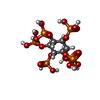


| #6: Chemical | | #7: Chemical | #8: Chemical | ChemComp-IHP / | |
|---|
-Details
| Has ligand of interest | N |
|---|
-Experimental details
-Experiment
| Experiment | Method: ELECTRON MICROSCOPY |
|---|---|
| EM experiment | Aggregation state: PARTICLE / 3D reconstruction method: single particle reconstruction |
- Sample preparation
Sample preparation
| Component | Name: SK7 complex / Type: COMPLEX / Entity ID: #1-#5 / Source: RECOMBINANT | ||||||||||||||||||||||||||||||
|---|---|---|---|---|---|---|---|---|---|---|---|---|---|---|---|---|---|---|---|---|---|---|---|---|---|---|---|---|---|---|---|
| Molecular weight | Value: 0.8178 MDa / Experimental value: NO | ||||||||||||||||||||||||||||||
| Source (natural) | Organism:  Homo sapiens (human) Homo sapiens (human) | ||||||||||||||||||||||||||||||
| Source (recombinant) | Organism:  Baculovirus expression vector pFastBac1-HM / Strain: High Five / Plasmid: pBIG1a Baculovirus expression vector pFastBac1-HM / Strain: High Five / Plasmid: pBIG1a | ||||||||||||||||||||||||||||||
| Buffer solution | pH: 7.5 | ||||||||||||||||||||||||||||||
| Buffer component |
| ||||||||||||||||||||||||||||||
| Specimen | Conc.: 2 mg/ml / Embedding applied: NO / Shadowing applied: NO / Staining applied: NO / Vitrification applied: YES | ||||||||||||||||||||||||||||||
| Specimen support | Details: The grid was coated with gold prior to use / Grid material: GOLD / Grid mesh size: 300 divisions/in. / Grid type: Quantifoil R1.2/1.3 | ||||||||||||||||||||||||||||||
| Vitrification | Instrument: FEI VITROBOT MARK IV / Cryogen name: ETHANE / Humidity: 100 % / Chamber temperature: 277 K |
- Electron microscopy imaging
Electron microscopy imaging
| Experimental equipment |  Model: Titan Krios / Image courtesy: FEI Company |
|---|---|
| Microscopy | Model: FEI TITAN KRIOS |
| Electron gun | Electron source:  FIELD EMISSION GUN / Accelerating voltage: 300 kV / Illumination mode: FLOOD BEAM FIELD EMISSION GUN / Accelerating voltage: 300 kV / Illumination mode: FLOOD BEAM |
| Electron lens | Mode: BRIGHT FIELD / Calibrated magnification: 59524 X / Cs: 2.7 mm / C2 aperture diameter: 70 µm / Alignment procedure: COMA FREE |
| Specimen holder | Cryogen: NITROGEN / Specimen holder model: FEI TITAN KRIOS AUTOGRID HOLDER |
| Image recording | Electron dose: 64 e/Å2 / Detector mode: SUPER-RESOLUTION / Film or detector model: GATAN K3 (6k x 4k) / Num. of real images: 4356 |
| Image scans | Movie frames/image: 32 |
- Processing
Processing
| EM software |
| ||||||||||||||||||||||||||||||||||||
|---|---|---|---|---|---|---|---|---|---|---|---|---|---|---|---|---|---|---|---|---|---|---|---|---|---|---|---|---|---|---|---|---|---|---|---|---|---|
| CTF correction | Type: PHASE FLIPPING AND AMPLITUDE CORRECTION | ||||||||||||||||||||||||||||||||||||
| Particle selection | Num. of particles selected: 2451582 | ||||||||||||||||||||||||||||||||||||
| Symmetry | Point symmetry: C1 (asymmetric) | ||||||||||||||||||||||||||||||||||||
| 3D reconstruction | Resolution: 3.3 Å / Resolution method: FSC 0.143 CUT-OFF / Num. of particles: 87779 / Symmetry type: POINT | ||||||||||||||||||||||||||||||||||||
| Atomic model building | Protocol: AB INITIO MODEL / Space: REAL | ||||||||||||||||||||||||||||||||||||
| Atomic model building |
|
 Movie
Movie Controller
Controller



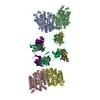


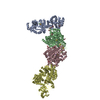

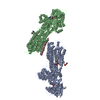
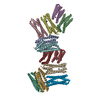
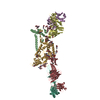
 PDBj
PDBj
























